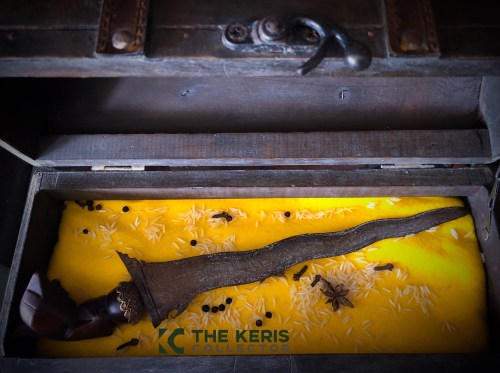“There is no such thing as mysticism or paranormal in this world. It is just a state of reality that our human mind is not ready to accept and understand with an enlightened heart”
Md Din Md
December 2004
A little over 15 years ago, when I began to actively pursue my interest in the keris art and lore, I had the great fortune to meet an extraordinary gentleman by the name of Md Din Md. A man with an extraordinary reputation in Singapore’s Arts and Culture scene and also a collector of kerises (impressive collection by the way), rare antiquities and curios.
On the subject of the keris, one of the memorable tutelage I personally received from him was on the aspect of keris care, storage and maintenance. Many guidance did I receive and personally most of which I have not heard being shared by other collectors after that.
As part of my contribution to the study of the keris, I would like to share some unconventional yet practical and feasible practices in keris storage.
When it comes to keris storage, numerous taboos and “pantangs” abound. Most of it is drenched with mystical beliefs which may have arise from irrational fear due to a lack of understanding, ignorance or just plain indifference.
A keris ideally is stored on top of a high shelf or hanged up high on the wall. The common reasoning for this – a keris needs to be respected else misfortune will befall the household. This may have been a too simplistic a reasoning by the elders to ensure that heirs abide by this instructions strictly. An overly romanticised notion but it’s rationale can be defined logically if one is able to put aside irrational and unfounded beliefs.
A keris is still a weapon after all, one simply don’t leave a weapon lying around for an innocent child to play and might possibly inflict injury to self or others in the process. Hence this is the precautionary aspect of “misfortune will befall the household” part.
Another means of storage which was highly recommended, was to keep them stored in a wooden chest (usually secured with a lock and key) which was a common piece of furniture accessory found in many traditional households back in the day. However certain conditions must be fulfilled when storing kerises in such a manner.
Four items must be placed together inside the wooden chest. These items are as follows:
- A handful (segenggam) of uncooked rice (beras mentah).
- A handful (segenggam) of cloves (cengkeh).
- A handful (segenggam) of star anise (bunga lawang).
- A handful (segenggam) of black pepper seeds (biji lada hitam).
These ingredients sounds familiar to Malay traditional healing does it not? Hence one would immediately presume to confer mystical elements to such a practice. But in truth, the science behind this practice will astonish you.

The element of the four corners is pre-dominant in many pre-Islamic practices – Mandalas. Though Islam has become the dominant religion embraced by the Malays of Nusantara, tributes to the old ways are still being done unconsciously. The keris is an example itself. It embodies Hinduism, Buddhism and Islam into its artistry and presentation. Hence even in the art of storage of keris, tribute to the four corners are offered as a symbolic gesture. Whilst it is fun to entertain the idea that the “offerings” are for appeasing some unseen deities of old, the secret to the science involved is very interesting and much more logical compared to giving in to an irrational fear from a threat that may just be borne from the uneducated mind.
What is so special about these four ingredients that warrants its importance as a critical component to storage of a keris in a wooden chest? Read on to find out more.

Sounds Mystical Does It Not?
1. Un-Cooked Rice (Beras Mentah)
Uncooked rice is a natural de-humidifier. It absorbs moisture from its surroundings. Before the advent of silica gel beads, the Malays have discovered the moisture absorbing properties of uncooked rice and tapped on this feature in keeping their prized possessions free of moisture. Brilliant and certainly a commonly available ingredient in any kitchen today.
2. Cloves (Cengkeh)
Cloves have the following natural properties, firstly it anti-microbial, it kills microbes. Secondly, it is a natural deodorant, cloves gives off this natural pleasant refreshing scent and thirdly, naturally it too repels insects and pests. This feature makes it one of the most essential since keris parts are mostly made of wood, wood eating insects are its proverbial Achilles heel. Having something to repel such pests is a God-sent indeed.
3. Star Anise (Bunga Lawang)
Star anise, just like cloves, not only posses anti-microbial properties, it also is anti-fungal. This is also a sought after natural feature. Wood is prone to fungus in humid conditions, and with a few of these natural anti-fungal agent around, it will definitely prevent or curb the growth of wood-borne fungus.
4. Black Pepper Seeds (Lada Hitam)
Black pepper seeds, just like the cloves and star anise, too posses similar natural traits. It is an anti-microbial, anti-fungal and a natural insect repellant. From what I was told, a repels a specific pest – the woodlice which may be resistant to star anise and cloves.
All four of the above mentioned ingredients are common in most household kitchen today and are the more economical alternatives to modern chemicals and contraptions.
To date, I have not read of this guide written in any books or shared orally by any other keris collectors. In honour of my late mentor, Md Din Md, who was kind enough to share this information, orally with me, from his experience and learning, I now share this information with all of you. May this snippet of knowledge serve you well and please share it to whomever is interested.
Personally, I have adopted this practice for years and especially for my collections stored in my private storage facilities at remote sites and this method which I have described above, is very economical and cost effective. Happy trying.
Sincerely,
JoFe,
24 March 2019


